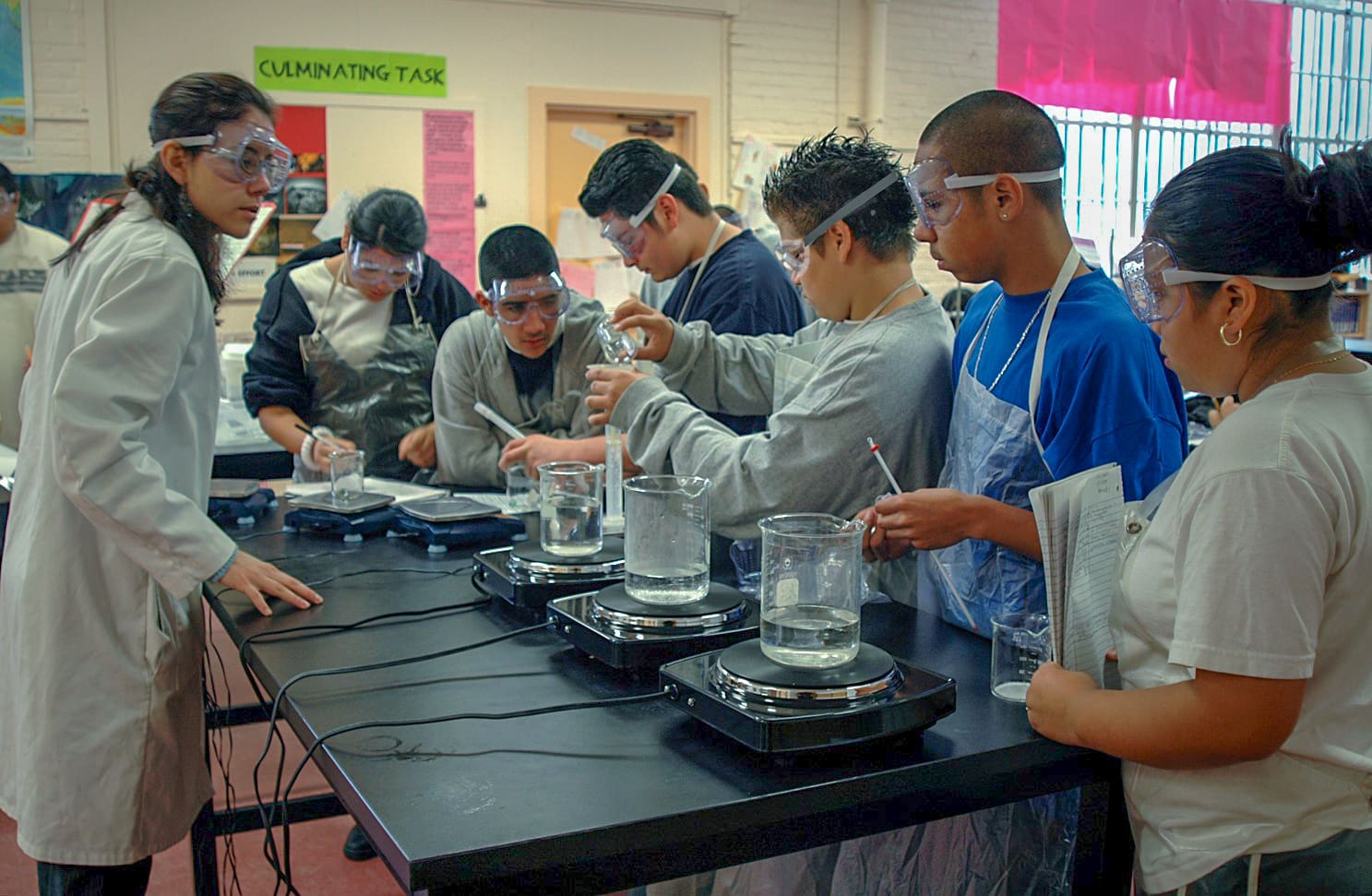Solving the High School Science Curriculum Crisis (part 3)

QuickTake: Over 92% of high school science teachers report using no comprehensive high school science curriculum aligned to academic standards. In this final installment of our 3-part series on the future of high school STEM education, see how this crisis in coherent instructional materials impacts engagement and equity and how Activate Learning’s flexible solution equips teachers and unlocks high-quality science learning for all!
Welcome back to the final installment of our enlightening series on the future of High School STEM education.
In the first installment of this blog series, The Power of Project-Based Learning: Connecting High School STEM to the Real World, we discussed the power of project-based learning to connect high school STEM concepts to the real world. We explored how Activate Learning programs like Active Chemistry and Active Physics immerse students in authentic scenarios to develop critical professional skills.
We examined innovations around the high school science course sequence in the second post, Rethinking the High School Science Course Sequence. We looked at how OpenSciEd’s new 3-year high school curriculum integrates Earth and Space Sciences (ESS) and Engineering (ETS) throughout the high school program, providing a more cohesive and interconnected learning experience than traditional course sequences.
In this final blog series entry, we will tackle a major obstacle still hindering equitable access to quality science education: the lack of comprehensive, standards-aligned high school science curriculum and teaching materials. Recent research from EdReports highlights alarming statistics around this deficiency, signaling a curriculum crisis that disproportionately impacts disadvantaged students. These challenges have significant implications for students' science literacy and preparedness for college and careers.
The good news? This research also points to solutions, including the kind of flexible, consistent high school science programs Activate Learning provides. Let’s explore the roots of this crisis, its far-reaching effects on students, and how schools can turn the tide to enable phenomenal STEM learning for all.
Identifying the Crisis in High School Science Curriculum
The landscape of high school science education in the United States presents a stark and troubling reality. Recent research from independent non-profit EdReports exposes alarming deficiencies in high school science curriculum and instructional materials. Over 92% of high school science teachers report using no comprehensive instructional materials aligned to academic standards. Without access to a complete, standards-based curriculum, the majority of educators are left piecing together disjointed resources on their own.
This crisis in quality materials significantly impacts student learning. Teachers spend over 12 hours per week searching for haphazard content, contributing to teacher burnout and taking time away from meaningful classroom instruction. Students subsequently receive fragmented, inconsistent exposure to science concepts across grades 9-12. This further exacerbates existing equity gaps, as under-resourced schools already struggle to provide coherent learning experiences compared to affluent districts.
However, the crisis extends beyond time constraints and alignment issues. At its core, this lack of comprehensive curriculum denies students their right to an equitable, high-quality science education that properly prepares them for college and career success. As EdReports’ research notes, “To be truly prepared...high school students need a set of science programs that are grade-level and engaging, and that collectively address modern science standards across a learner’s 9-12 journey.”
With over 90% of students lacking access to appropriately aligned materials, our current system is far from this vision. Closing this gap requires recognizing curriculum limitations as a crisis point so that schools can take urgent action to ensure phenomenal STEM education for all and provide the support teachers need to implement solutions.
The Root Cause of the Problem: Standards Confusion
What factors underlie this crisis in high-quality high school science curricula?
A major contributor is the lack of consistency around academic standards in science education. Across the country, there's a significant divergence in the adoption and interpretation of the Next Generation Science Standards (NGSS) or standards based on A Framework for K–12 Science Education. As EdReports details, there is “huge national variation in what ‘high school science’ means and what’s expected of students.” Unlike more unified subjects like English and Math, interpretations of science standards vary widely in aspects like the adoption of NGSS, graduation requirements, and course sequence design.
This confusion trickles down into fractured high school science course offerings that worsen curriculum gaps. Most high school science programs are single-subject courses like biology or chemistry that cover standards in isolation. Even within the same subject, content alignment to standards fluctuates wildly between texts.
Exacerbating matters is the absence of coordination in the adoption of course materials. As EdReports found, “High school science programs are most commonly selected by individual teachers, and holistic selection processes are relatively uncommon.” This decentralized decision-making leads districts to lack vertical alignment across grade bands.
The result is a disconnected patchwork of single-subject courses with inconsistent, narrow standards attention. Students subsequently piece together an incomplete 9-12 science education, leaving severe gaps in their learning. Creating a coherent, equitable curriculum requires addressing the root causes of fragmented, inadequate course materials.
The Ripple Effects of this High School Science Curriculum Crisis
The consequences of this crisis in high school science curriculum quickly compound, creating detrimental ripple effects.
Most glaringly, the need for more coherent materials severely impacts student engagement and preparation for higher education and careers. Students struggle to connect classroom concepts to real-world applications without relevant, integrated content. This hampers the development of critical thinking, collaboration, and problem-solving skills that college and the modern workforce demand. Furthermore, students face a rapidly evolving world where scientific innovations necessitate quick adaptation to emerging technologies and sciences.
Moreover, a deficient curriculum further stacks the odds against disadvantaged students already facing systemic barriers. Schools serving predominantly low-income communities have fewer resources to provide complete science programming aligned to standards. This deepens existing achievement gaps compared to affluent districts.
As EdReports’ equity research explains, “This is particularly significant for students of color and students living in poverty who have less access to high-quality, standards-aligned content than their peers.” An incoherent curriculum only widens these divides early on, limiting students’ opportunities before they even enter higher education or the job market.
Poorly coordinated, piecemeal science materials have resonant impacts stretching from student engagement to compounding equity gaps. Finding solutions to this crisis is imperative to ensure ALL students receive excellent preparation for lifelong success.
Turning the Tide: Activate Learning’s Unified Science Curriculum Solution

While the scope of the high school science curriculum crisis is daunting, solutions exist to chart a new course for student success. As an established leader in K-12 STEM education, Activate Learning offers a unified curriculum solution that can help schools turn the tide.
Our high school programs provide the elements called for in EdReports’ research - comprehensive, standards-aligned science curriculum materials that are flexible for diverse needs. For example:
Active Chemistry brings the world of molecules and reactions to life through a project-based approach that engages students in real-world challenges. It’s not just about learning chemical formulas; it's about understanding their impact and application in everyday life. This curriculum ensures that students don’t just memorize concepts but internalize and apply them, preparing them for future scientific and career challenges. [learn more]
Active Physics introduces students to the fundamental principles of physics in a manner that resonates with their daily experiences. From understanding the mechanics of everyday objects to exploring the vastness of the cosmos, Active Physics makes the subject accessible and relevant. It encourages students to question, experiment, and discover, laying a solid foundation for scientific inquiry and reasoning. [learn more]
EarthComm takes students on a journey through the dynamic Earth and space sciences. It fosters an understanding of our planet and beyond, emphasizing the interconnectivity of Earth's systems. This curriculum not only educates but also instills a sense of stewardship for our planet, encouraging students to think critically about environmental issues and solutions. [learn more]
Engineering the Future guides students through practical real-world STEM connections so students have an opportunity to see how science, mathematics, and engineering are part of their everyday world, and why it is important for every citizen to be technologically and scientifically literate. [learn more]
The flexibility of our high school science curriculum and instructional materials allows for customization to meet the unique needs of different classrooms and districts, whether it’s adapting to varying levels of scientific understanding or integrating local and regional contexts into the curriculum.
Our evidence-based courses serve as a complete single-subject curriculum. Rigorously developed by subject matter experts and through extensive classroom testing, these programs maintain strict alignment with NGSS and the Framework for K-12 Science Education. This adherence to research-backed best practices ensures both rigor and relevance tailored to the latest scientific advances.
Schools can, at last, build a foundation for equitable access to phenomenal science education, enabling deep exploration of concepts across a coherent 9-12 sequence.
Science Materials Adoption: Personalized Professional Learning and Support
EdReports’ research also reveals best practices for curriculum adoption, emphasizing the value of educator expertise and stakeholder input. This aligns directly with Activate Learning’s approach. As we’ve detailed in recent case studies, our dedicated team provides end-to-end support, from materials selection through ongoing implementation and improvement.
The process begins with understanding district and school needs. Activate Learning works closely with administrators, leaders, and teachers to articulate a shared instructional vision and identify current gaps. Bringing these critical perspectives together ensures that selected materials match unique priorities.
Next, our curriculum specialists help navigate available options, providing actionable insights on how programs address vision elements and standards. For high school science, we offer in-depth guidance on how our various courses scaffold key skills and concepts across grades 9-12.
Activate Learning stresses the importance of ongoing professional learning throughout decision-making and beyond. Our professional learning team provides immersive training for understanding science curriculum design and making instructional choices that optimize materials for all students. Teachers gain confidence leveraging programs to accelerate achievement. And they become confident and inspired throughout the process!
By centering stakeholder voices and building educator expertise, Activate Learning powers the adoption of impactful, student-focused materials. Combined with our unified curriculum solutions, this approach delivers the missing elements that the EdReports research proposes.
Envisioning Quality Science Education for All High School Students!
The crisis in high school science curriculum access demands urgent solutions. Using cohesive, comprehensive science curriculum throughout high school is vital for developing students' deep, enduring understanding of scientific concepts.
Cohesive materials facilitate an integrated approach to science education. A consistent curriculum across grades ensures cumulative learning, the gradual development of critical analysis and problem-solving skills, and a uniform pedagogical approach that helps students adapt to expectations.
As we explored in this 3-part blog series, Activate Learning provides answers through comprehensive programs, adoption guidance, and ongoing professional learning. With these innovative tools, all students can acquire high-quality, engaging science education. Teachers can focus on what they do best — preparing young minds for the future.
While progress isn't linear, the path forward looks bright. Equipped with a unified vision, educators can move closer to quality science instruction for high school students! 🚀
* * * * *


![OpenSciEd Universal Design for Learning Header Image (OSE students by nicolejbolduc) [PHOTO: 7th grade students analyzing data together in an exercise from OpenSciEd Unit 6.4. CREDIT: @nicolejbolduc/Twitter]](https://activatelearning.com/wp-content/uploads/bb-plugin/cache/OpenSciEd-Universal-Design-for-Learning-Header-Image-OSE-students-by-nicolejbolduc-1024x512-panorama-56d0d80e31176175c2818d16d199cd62-.png)

